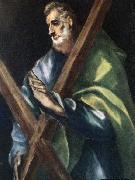La Peinture à l'huile en gros de Chine & Encadre |
|||||||||||

|
|||||||||||
|
|
|
|||||||||||||||
|
GRECO, El
Greek-born Spanish Mannerist Painter, 1541-1614 |
|
||||||||||||||
|
|
|||||||||||||||
|
|||||||||||||||
|
|
|||||||||||||||
| GRECO, El
Greek-born Spanish Mannerist Painter, 1541-1614 Apostle_St_Andrew 97 x 77 cm Museo de El Greco, Toledo Apostle, was brother of Peter, a Galilean fisherman, and the first to follow Christ (John 1:40-41). The gospels contribute little to his iconography; the chief source is the apocryphal book of the 'Acts of Andrew' (3rd century), retold in the Golden Legend. According to this he made missionary journeys to Scythian Russia, Asia Minor and Greece, preaching and performing many acts of healing. At Nicaea he delivered the inhabitants from seven demons who plagued them in the shape of dogs. At Thessalonica the parents of a young man whom he had converted to Christianity set fire to his house, with Andrew and their son in it. When the young man miraculously extinguished the fire by sprinkling a small bottle of water over the flames, his parents, still seeking vengeance, tried to enter the house by climbing ladders, but were immediately struck blind. The Golden Legend tells of a bishop dining with the devil, disguised as a courtesan. Just as he was about to yield to Satan, Andrew entered in the garb of a pilgrim, and drove the devil away. Andrew was executed by Egeas, the Roman governor of Patras in the Peloponnese. The governor's wife, Maximilla, being cured of a fatal sickness by the apostle, adopted Christianity and was persuaded by him to deny her husband his marital rights ever again. This, and not his preaching, seems to have been the cause of Andrew's imprisonment and subsequent crucifixion. Andrew is the patron saint of Greece and Scotland. Among differing accounts of his relics, one tells of their being carried to the town of St Andrews in Scotland in the 4th century. Apostle St Andrew in Art He is usually portrayed as an old man, white-haired and bearded. His chief attribute is a cross in the shape of an X, or saltire, though in earlier Renaissance painting he may have the more familiar Latin cross. He sometimes has a net containing fish, or a length of rope (he was bound, not nailed, to the cross). His inscription from the Apostles' Creed is: 'Et in Jesum Christum, filium ejus unicum Dominum nostrum'. All these episodes from the legends are depicted, also the stages of his martyrdom: scourging; led by soldiers to his execution; being tied to the cross; crucifixion; burial, assisted by Maximilla. Author: GRECO, El Title: Apostle St Andrew , 1551-1600 , Spanish Form: painting , religious 97 x 77 cm Museo de El Greco, Toledo Apostle, was brother of Peter, a Galilean fisherman, and the first to follow Christ (John 1:40-41). The gospels contribute little to his iconography; the chief source is the apocryphal book of the 'Acts of Andrew' (3rd century), retold in the Golden Legend. According to this he made missionary journeys to Scythian Russia, Asia Minor and Greece, preaching and performing many acts of healing. At Nicaea he delivered the inhabitants from seven demons who plagued them in the shape of dogs. At Thessalonica the parents of a young man whom he had converted to Christianity set fire to his house, with Andrew and their son in it. When the young man miraculously extinguished the fire by sprinkling a small bottle of water over the flames, his parents, still seeking vengeance, tried to enter the house by climbing ladders, but were immediately struck blind. The Golden Legend tells of a bishop dining with the devil, disguised as a courtesan. Just as he was about to yield to Satan, Andrew entered in the garb of a pilgrim, and drove the devil away. Andrew was executed by Egeas, the Roman governor of Patras in the Peloponnese. The governor's wife, Maximilla, being cured of a fatal sickness by the apostle, adopted Christianity and was persuaded by him to deny her husband his marital rights ever again. This, and not his preaching, seems to have been the cause of Andrew's imprisonment and subsequent crucifixion. Andrew is the patron saint of Greece and Scotland. Among differing accounts of his relics, one tells of their being carried to the town of St Andrews in Scotland in the 4th century. Apostle St Andrew in Art He is usually portrayed as an old man, white-haired and bearded. His chief attribute is a cross in the shape of an X, or saltire, though in earlier Renaissance painting he may have the more familiar Latin cross. He sometimes has a net containing fish, or a length of rope (he was bound, not nailed, to the cross). His inscription from the Apostles' Creed is: 'Et in Jesum Christum, filium ejus unicum Dominum nostrum'. All these episodes from the legends are depicted, also the stages of his martyrdom: scourging; led by soldiers to his execution; being tied to the cross; crucifixion; burial, assisted by Maximilla. Author: GRECO, El Title: Apostle St Andrew , 1551-1600 , Spanish Form: painting , religious |
|||||||||||||||
|
Related Paintings to GRECO, El :. |
|||||||||||||||
|
|
|||||||||||||||
|
|
|||||||||||||||
|
CONTACTER DES Etats-Unis |







